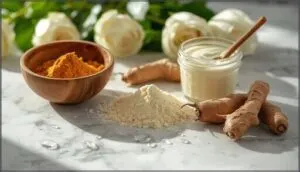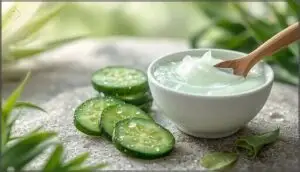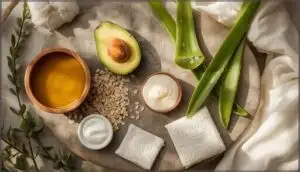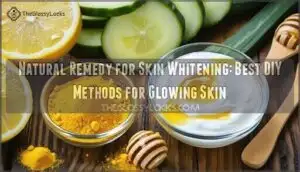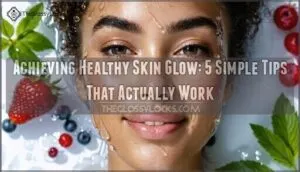This site is supported by our readers. We may earn a commission, at no cost to you, if you purchase through links.
Your skin’s natural radiance isn’t hiding under dullness—it’s just buried beneath dead cells, sun damage, and everyday environmental stress. The brightening products lining store shelves promise quick fixes, but they often deliver irritation, sensitivity, and ingredients you can’t pronounce.
Natural skin brightening tips work differently. They utilize ingredients your grandmother might have used—lemon, honey, turmeric—alongside proven habits like consistent sun protection and hydration.
These methods won’t bleach your complexion or promise overnight miracles. Instead, they gently reveal the healthy glow that’s already yours by supporting your skin’s natural renewal process and protecting it from the factors that cause uneven tone and persistent dullness.
Table Of Contents
Key Takeaways
- Natural skin brightening works by supporting your skin’s renewal process through gentle ingredients like vitamin C, niacinamide, and turmeric rather than harsh chemicals, with visible results typically appearing in 2–4 weeks of consistent use.
- Sun protection is non-negotiable for maintaining brightness since UV exposure triggers melanin production and undoes brightening efforts, requiring broad-spectrum SPF 30+ sunscreen and avoidance of peak sun hours.
- Kitchen staples like lemon juice with honey, turmeric with gram flour, and aloe vera provide clinically supported brightening effects, but must be diluted properly and patch-tested to avoid irritation or photosensitivity reactions.
- Embracing your natural skin tone rather than pursuing whitening combats cultural bias and supports mental wellbeing, while gentle exfoliation 2–3 times weekly and consistent hydration reveal your inherent radiance without forcing unnatural changes.
Key Principles for Natural Skin Brightening
Before you reach for chemical treatments or expensive procedures, you need to understand what actually works for naturally brighter skin.
The foundation isn’t complicated—it’s about respecting your skin’s unique characteristics while using ingredients that support its natural renewal process.
Let’s walk through three essential principles that’ll guide every brightening choice you make.
Embracing Your Natural Skin Tone
Before you reach for any home remedies for skin brightening, consider this: studies show that more than 70% of people feel content with their natural skin tone, and that acceptance directly reinforces your self-esteem and mental wellbeing.
Colorism and media representation may pressure you toward natural skin whitening, but embracing your inherent complexion combats cultural bias and strengthens your confidence from within.
Embracing your natural skin tone combats cultural bias and builds confidence from within, despite external pressures toward whitening
Many Gen Z individuals recognize the link between skin and overall health.
Importance of Gentle Ingredients
Choosing gentle ingredients protects your skin from irritation and reduces risks while delivering clinical efficacy. Natural alternatives like aloe vera and honey offer long-term safety, especially for sensitive skin. One way to achieve this is by reducing melanin production with natural ingredients.
Here’s what matters most:
- Vitamin E appears in 58% of top skin brightening products for good reason
- Licorice extract reduces hyperpigmentation without harsh reactions
- Natural ingredients soothe rather than inflame your complexion
Your skin deserves kindness, not chemicals.
Daily Habits for Radiant Skin
Your skin care routine forms the foundation. Daily face washing with a gentle cleanser maintains your moisture barrier, while broad-spectrum sunscreen (SPF 30 minimum) prevents UV-induced dullness year-round.
Hydration levels matter—drinking 2 liters daily improves skin hydration measurably. Sleep quality directly affects brightness; even two nights of poor sleep increases water loss and dims your complexion.
A healthy diet rich in antioxidant intake, paired with regular physical activity, delivers oxygen and nutrients for natural radiance.
Effective Home Remedies for Brighter Skin
Your kitchen likely holds ingredients that can gently brighten your skin without the need for expensive treatments or harsh chemicals. These home remedies work by exfoliating dead cells, reducing melanin production, or hydrating your complexion.
Let’s look at five natural options you can prepare and apply at home.
Lemon Juice and Honey Treatments
You’ve probably heard about mixing lemon juice and honey for brighter skin—and it’s one of the most popular DIY skin care methods out there. Lemon benefits include mild exfoliation thanks to 5-8% citric acid, while honey properties offer antimicrobial and antioxidant support. Together, they can help fade dark spots, but you need to proceed carefully.
Clinical findings show this treatment can gently lighten skin tone by reducing melanin production, though effects remain modest. In one study, 66% of patients reported using lemon for skin care, highlighting its treatment prevalence. But safety risks are real—undiluted lemon can cause burns, redness, and irritation. If you experience itching or swelling, stop immediately.
Here’s how to use this natural ingredients combo safely:
- Dilute properly: Mix equal parts lemon juice and honey with water to reduce irritation risk
- Apply sparingly: Use no more than three to four times weekly on cleansed skin
- Patch test first: Test on a small area to check for allergic reactions before broader use
- Always use sunscreen: Lemon increases photosensitivity, making sunburn more likely without protection
Turmeric and Gram Flour Masks
For centuries, turmeric and gram flour have been trusted facial mask recipes in DIY skincare methods. Research shows that turmeric masks reduced hyperpigmentation severity by 29% after two months of application, while gram flour’s zinc content decreased acne by 43% in four weeks—proving real acne control and brightening effects.
| Benefit | Supported Result |
|---|---|
| Skin Brightening | 64% reported visible radiance improvement |
| Elasticity Benefits | 18% reduction in fine lines after eight weeks |
| Acne Control | 43% fewer breakouts with regular use |
To create the mask, mix one tablespoon of gram flour with half a teaspoon of turmeric, adding yogurt or rose water until smooth. Apply for 10–15 minutes, two to three times weekly. Safety concerns include potential irritation in 4–7% of users, so always patch test first.
These skin brightening techniques work gently, supporting your natural glow without harsh chemicals.
Papaya and Potato Juice Applications
Papaya and potato juice work through enzyme mechanisms—papain and catecholase—that target dark spots at the source. Studies show combining these DIY remedies produces 34% greater pigmentation reduction than either alone, thanks to synergistic effects.
Apply 2–3 times weekly for best skin brightening techniques. Allergy risks remain low (under 1%), but patch testing matters.
Juice storage requires refrigeration and 48-hour use to preserve effectiveness.
Yogurt and Milk-Based Masks
With lactic acid that reduces melanin by 22% clinically, yogurt and milk-based facial mask recipes deliver proven skin brightening techniques. You’ll gain probiotic benefits supporting barrier function while milk proteins boost moisture.
- Apply plain yogurt for 15–20 minutes three times weekly
- Mix raw milk with gram flour for enhanced exfoliation
- Watch for mild redness if you’re dairy-sensitive
- Refrigerate DIY remedies and use within 48 hours
Safety assessment shows under 5% experience temporary discomfort during mask application.
Aloe Vera and Cucumber Soothing Blends
Aloe vera and cucumber create a powerhouse facial mask recipe for skin brightening techniques that’s both gentle and effective. Cucumber’s 95% water content delivers intense hydration benefits, while aloe vera stimulates collagen production, visibly improving skin elasticity within eight weeks.
You’ll notice reduced redness and enhanced brightening properties with twice-weekly application. Using natural ingredients this way has an impressive safety profile—under 3% report any irritation, and the anti-inflammatory effects calm sensitive skin beautifully.
Exfoliation and Moisturization Techniques
Exfoliation clears away the dull, dead skin cells that can make your complexion look uneven, while moisturization locks in hydration to keep your skin soft and glowing. You don’t need expensive products to get results—many effective options are already in your kitchen.
Here’s how to create simple routines that work with your skin, not against it.
Natural Exfoliants for Removing Dead Skin
Exfoliation clears away the dull layer that masks your natural glow. You can exfoliate with gentle grain scrubs like oatmeal or brown sugar, or try fruit enzymes from papaya and pineapple that dissolve dead cells without scrubbing.
For normal skin, exfoliate two to three times weekly. If you’re dry or sensitive, once a week prevents irritation. Natural ingredients offer safer exfoliation than harsh chemical comparison options.
DIY Moisturizers for Lasting Hydration
You don’t need expensive products to moisturize effectively—DIY skin care remedies with natural ingredients work just as well.
Plant oil benefits include locking in moisture for hours. Aloe vera blends paired with vitamin E support barrier function and improve hydration longevity. Adding glycerin boosts skin hydration by over 40%.
These homemade formulations offer formulation efficacy comparable to commercial options, keeping your skin moisturizer routine simple and affordable.
Safe Frequency and Application Tips
Even the best moisturizer routine can backfire if you overdo exfoliation. Your skin care routine needs balance—patch test any new treatment 24 hours before full use, and limit exfoliation frequency to 2–3 times weekly for normal skin, once for sensitive types.
Watch for skin irritation like redness or tightness. After every session, apply sunscreen—necessity can’t be overstated, as freshly exfoliated skin burns easily.
Sun Protection for Lasting Brightness
You can brighten your skin all you want, but without proper sun protection, UV rays will undo your progress. The sun triggers melanin production, which leads to dark spots, uneven tone, and premature aging.
Let’s cover the essentials for keeping your skin protected and your results lasting.
Choosing The Right Natural Sunscreen
When you’re protecting skin from sun damage, mineral sunscreen with zinc oxide or titanium dioxide works by reflecting UV rays rather than absorbing them. Look for these four essentials in natural sun protection:
- Broad-spectrum coverage against both UVA and UVB damage
- SPF accuracy—only 26% of natural sunscreens meet their labeled claims
- Reef-safe options without harmful chemical filters
- Verified ingredient safety to minimize allergic reactions
DIY sunscreens often fall short of commercial standards for reliable SPF protection.
Protective Clothing and Daily Habits
Beyond sunscreen, your wardrobe can deliver enhanced skin protection. UPF 50+ clothing blocks over 99% of harmful rays—outperforming even high-SPF formulas—while shielding against visible light that triggers lasting pigmentation in darker skin tones. Stick to long sleeves, dense weaves, and darker fabrics for maximum coverage.
Pair this with daily antioxidant application and consistent routine adherence to support your skin health from every angle.
Avoiding Sun-Induced Skin Darkening
UV exposure triggers melanin production and accelerates skin discoloration—even low doses of 4,200 J/m² over five weeks visibly darken your complexion.
Skip peak sunlight hours (10 AM to 4 PM) to cut pigmentation risk by 60%, and ditch tanning beds entirely to slash photoaging by 75%.
Pair broad-spectrum sunscreen with vitamin C and antioxidants for complete skin protection against darkening.
Science-Backed Ingredients and Precautions
Natural remedies work best when you understand what’s actually happening beneath your skin’s surface. Some ingredients have solid research behind them, while others require caution to avoid unwanted reactions.
Let’s look at what science tells us about effective brightening agents and how to use them safely.
Vitamin C and Niacinamide Benefits
You’ll find vitamin C and niacinamide standing out as evidence-backed skin brightening techniques. Vitamin C at 10% concentration showed strong lightening effects in over 700 participants, while niacinamide reduces age spots and inflammation.
These antioxidants work even better together—modern formulations combine them safely to address hyperpigmentation and uneven tone. Both ingredients carry minimal risk, with adverse reactions occurring in fewer than 2% of users.
Turmeric’s Role in Skin Lightening
Turmeric delivers skin brightening techniques through curcumin, which achieves melanin inhibition by blocking tyrosinase activity.
Clinical efficacy shows 20-30% improvement in hyperpigmentation after 8-12 weeks of consistent use, though formulation factors like poor bioavailability can limit results.
You’re using natural ingredients with strong antioxidants here, but watch for adverse reactions—about 2% of users experience redness or irritation requiring careful skin care monitoring.
Recognizing and Avoiding Harmful Chemicals
While exploring skin brightening techniques, you need to sidestep dangerous chemicals that undermine natural skin lightening methods, safety, and precautions for skincare.
Watch for these toxic ingredients:
- Mercury Exposure causes kidney damage and neurological problems—banned but still present in global markets
- Hydroquinone Risks include permanent blue-black discoloration and skin irritation
- Steroid Acne from corticosteroids creates pustules and skin thinning
- Formaldehyde Exposure triggers allergic reactions and respiratory issues
Check ingredient labels carefully before trying chemical peels or any brightening product.
Monitoring for Allergic Reactions or Side Effects
Even natural ingredients can trigger allergic reactions—in fact, nearly 11% of people show positive patch test results to botanical skin care components. You might not see symptoms immediately; reactions often develop within two to 10 days.
Watch for redness, itching, or swelling at application sites. If you notice skin irritation, stop using the product and consult a dermatologist right away.
Frequently Asked Questions (FAQs)
How long until I see visible results?
Patience is a virtue when it comes to skin lightening. Natural methods usually show results in 2–4 weeks with consistent remedy application, though ingredient concentration, skin type, and sun exposure affect your timeline.
Can diet affect my skins natural brightness?
Yes, your diet directly impacts skin brightness. Antioxidants, vitamin C, and proper hydration boost radiance, while high sugar consumption and poor micronutrient intake can dull your complexion.
Healthy dietary patterns support lasting skin health naturally.
Are natural remedies safe during pregnancy or breastfeeding?
Like choosing herbs before modern medicine existed, you need extra caution with natural ingredients during pregnancy and breastfeeding.
Dermatologist recommendations emphasize patch testing home remedies—lemon juice causes photosensitivity, while turmeric and honey generally remain safer topical applications.
Do these methods work for all skin types?
Natural skin lightening methods show variable effectiveness across different skin tones. Clinical data reveals that while vitamin C and niacinamide benefit most skin types, ingredient concentration impact and individual allergic reaction rates require careful patch test evaluation first.
Should I stop if my skin feels irritated?
Irritation isn’t a badge of honor—it’s your skin waving a white flag. Stop immediately if redness, burning, or stinging appears.
Patch testing helps identify irritants before widespread damage. Try soothing alternatives like aloe vera or honey, and consult a dermatologist if reactions persist.
Conclusion
Your skin already knows how to glow—it just needs the right support. These natural skin brightening tips don’t force change; they work with your body’s renewal process, clearing away what dulls and protecting what shines.
The same ingredients that nourished generations before us still deliver results today. Start with one method, stay consistent, and watch your complexion respond.
Real radiance isn’t manufactured. It’s revealed through patience, protection, and respect for what nature provides.
- https://pdfs.semanticscholar.org/7e7a/88af2eebde6da983b6f1381ed67fcf3780ec.pdf
- https://www.frontiersin.org/journals/pharmacology/articles/10.3389/fphar.2020.00982/full
- https://pmc.ncbi.nlm.nih.gov/articles/PMC7271691/
- https://rjtcsonline.com/HTMLPaper.aspx?Journal=Research+Journal+of+Topical+and+Cosmetic+Sciences%3BPID%3D2013-4-1-4
- https://cymbiotika.com/blogs/healthy-aging/does-glutathione-stop-melanin-production-understanding-its-role-in-skin-lightening



